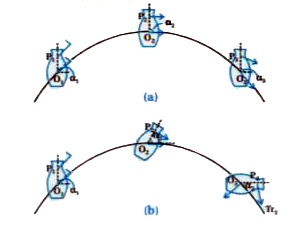Explain with illustration the pure translation and combination of translation and rotation motion of rigid body.
 Solution in Gujrati
Solution in Gujrati
Above two figures shows the different motion of the same body.
Suppose P is any point and its centre of mass is at O.
The trajectories of O are the translational trajectories Tr1andTr2 of the body.
The positions O and P at three different instants of time are shown by O1,O2,O3andP1,P2,P3 respectively in both the figure.
In figure (a) it is seen that position does not changes at different position. Line like OP have no orientation, the angle makes by OP in horizontal remains same.
∴α1=α2=α3
Such motion is a pure translation.
In pure translation motion particles like O and P have velocity at different position.
In figure (b) in case of combination of translation and rotation, the velocity of O and P differ.
∴α1≠α2≠α3.
Such type of motion is the combination of pure translation and combination of translation motion.
Another illustration of such type of motion :
Rolling motion of a cylinder is another illustration of this motion. Here the motion of rolling of cylinder on a slope about fixed axis the combination of rotation and translational motion.
If a motion of rigid body is not about any axis or not stationary it is pure translation or combination of translation and rotation motion.
If the motion of body is pivoted or stationary by any way then this motion is rotational motion.
Rotational motion may be about stationary and variable axis.
Topper's Solved these Questions
- SYSTEMS OF PARTICLES AND ROTATIONAL MOTIONBOOK - KUMAR PRAKASHANCHAPTER - SYSTEMS OF PARTICLES AND ROTATIONAL MOTIONEXERCISE - SECTION-A HOTS
3 Videos
- SYSTEMS OF PARTICLES AND ROTATIONAL MOTIONBOOK - KUMAR PRAKASHANCHAPTER - SYSTEMS OF PARTICLES AND ROTATIONAL MOTIONEXERCISE - SECTION-A (TRY YOURSELF (VSQs))
94 Videos
- QUESTIONS ASKED IN JEE - 2020 BOOK - KUMAR PRAKASHANCHAPTER - QUESTIONS ASKED IN JEE - 2020 EXERCISE - Question
16 Videos
- THERMAL PROPERTIES OF MATTERBOOK - KUMAR PRAKASHANCHAPTER - THERMAL PROPERTIES OF MATTEREXERCISE - Question Paper (Section - D) (Answer following in brief :) Each carry 4 marks
1 Videos
Similar Questions
What is torque? Explain the torque acting on a particle.
View SolutionWhat is a rigid body ? Explain the differences between rigid body and solid body.
View SolutionA non-isotropic solid metal cube has coefficient of linear expansion as 5×10−5/∘C along the x-axis and 5×10−6/∘C along y-axis and z-axis. If the coefficient of volumetric expansion of the solid is n×10−6/∘C then the value of n is....
View SolutionIn an experiment on the specific heat of a metal, a 0.20 kg block of the metal at 150∘C is dropped in a copper calorimeter (of water equivalent 0.025 kg) containing 150 cm3 of water at 27∘C. The final temperature is 40∘C. Compute the specific heat of the metal. If heat losses to the surroundings are not negligible, is your answer greater or smaller than the actual value for specific heat of the metal ?
View SolutionKinetic Energy Of A Body In Combined Rotation And Translation
View SolutionCOLLISION OF A PARTICLE WITH RIGID BODY ( FREE TO ROTATE AND TRANSLATE)
View SolutionAssertion : In rotational plus translational motion of a rigid body, different particles of the rigid body may have different velocities but they will have same accelerations Reason : Translational motion of a particle is equivalent to the translation motion of a rigid body.
View SolutionGENERAL RIGID BODY MOTION|TRANSLATIONAL|ROTATIONAL
View SolutionAngular momentum of a rigid body in pure translation | Pure rotation | Rotation plus translation
View SolutionStatement I : In rotational plus translational motion of a rigid body different particles of the rigid body may have different velocities but they will have same accelerations. Statement II : Translational motion of a particle is equivalent to the translational motion of rigid body.
View SolutionCBSE Special | Combined Rotation and Translation Motion of a Rigid Body
View SolutionPROBLEMS ON COMBINED ROTATION AND TRANSLATION MOTION
View SolutionExplain translational motion by given illustration.
View SolutionWhat is pure translational motion?
View SolutionWhat is combined translation and rotation motion?
View Solution
